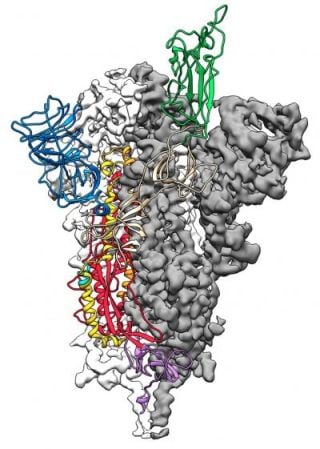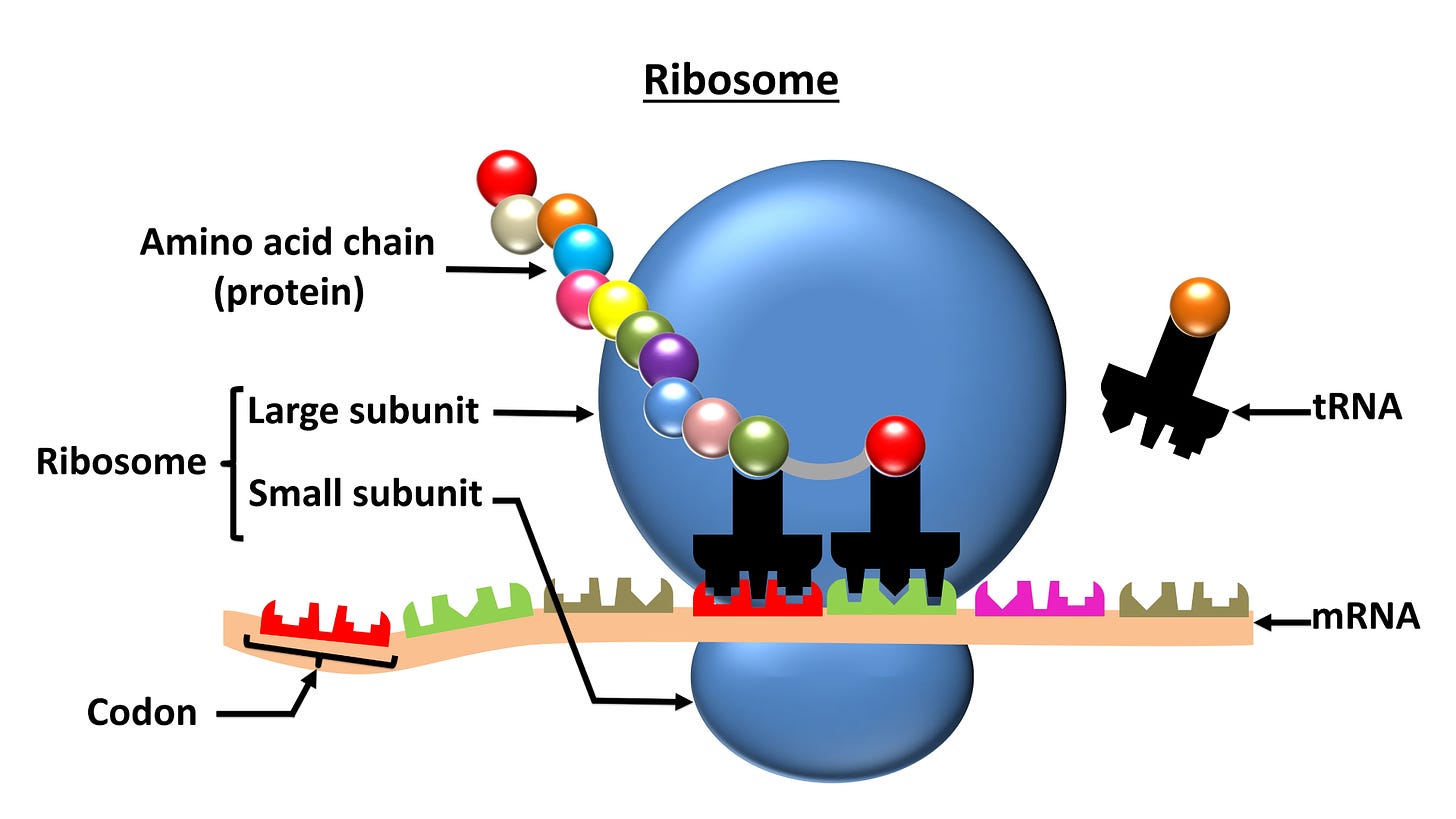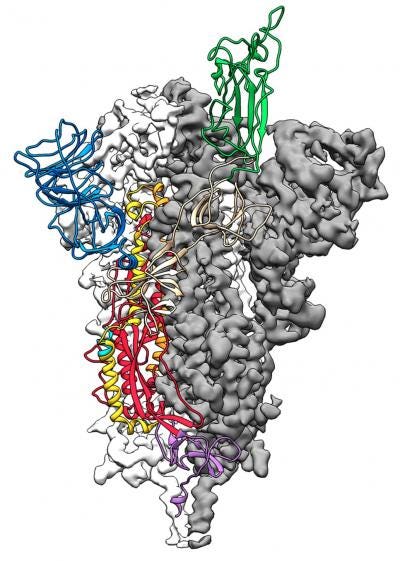The mRNA vaccines for COVID are doubly flawed. One problem in particular must have been known to the biochemists and the other to the leadership who choose to rely on these vaccines. The first problem is that the dose is uncontrolled; different people produce vastly different amounts of the spike protein from the same injection. The second is that the spike protein itself is the part of the virus that does damage to the human system. Any other part of the virus might have been a better choice for the target presented to the body to stimulate an immune response. Obviously, these problems are worse together than either separately.
Traditional vaccines use a whole, weakened virus or a chemical piece of the virus to give the body a headstart making an immune response to a pathogen that may be coming in the future. The mRNA vaccines from Pfizer and Moderna (but not the adenovirus vaccine from J&J) are based on a clever variation. Instead of delivering a protein from the virus, the vaccines deliver mRNA instructions for making this protein.
Every cell in our bodies* (and almost every plant and animal cell) has a nucleus with DNA and ribosomes for manufacturing proteins. The DNA doesn’t have chemical activity of its own, but acts as an information repository. Epigenetic chemical markers point to segments of the DNA that are to be activated. Activation starts with the DNA opening up and a a portion being copied into messenger RNA (mRNA). The mRNA then leaves the nucleus and goes out into the cell looking for a ribosome. The ribosome picks up the mRNA template and reads it, 3 bases at a time, translating the message into instructions for creating a protein. Then the mRNA is degraded so its parts can be recycled.
The mRNA vaccines contain instructions for making the spike protein from the SARS-CoV-2 virus associated with COVID. It is housed in a lipid nanoparticle = a tiny bubble of oil that allows it to pass through the cell membrane. (Normally the cell membrane would exclude any naked RNA molecule.) The vaccine mRNA is modified in several ways that make it both more efficient at producing the protein and also resistant to degradation afterward, so it can be used as a template many times.
This is a clever idea, and useful to the manufacturers because there are computer-controlled techniques for generating any desired strand of RNA, whereas manufacturing proteins is much more expensive, and growing viruses (even more so) requires bioreactors and not just chemical reactors. For these reasons, mRNA is a financially attractive experimental platform. But some preliminary research steps are necessary. Does the body respond to a “foreign” protein that is generated in its own cells in the same way that it responds to a wholly foreign invader? We don’t understand the immune system well enough to answer this question theoretically. Experiments to discover the answer were conducted beginning almost 30 years ago, and the results were characterized by the experimenters themselves as promising but not ready for prime time [review, history]
Before 2020, the only human trials were with cancer patients who served as willing subjects because they were already in a life-threatening situation. In desperate circumstances, larger risks of side effects may be justifiable. A vaccine delivered to billions of healthy people should be held to a tighter standard. It’s one thing to maim one in a thousand experimental subjects who are facing no better choices in a battle with cancer; it’s another thing entirely to maim millions of healthy people because billions have taken a vaccine which they were told was “safe and effective”. “Immunization of healthy individuals requires safety standards far beyond those applicable for therapeutic approaches.” [Roesler et al]
First flaw
One problem is that some cells allow the nanoparticles entry, while others don’t. Some people’s bodies see past the trick and degrade the mRNA in short order, while in other bodies, the mRNA lingers for months. In some people, the mRNA remains confined in the shoulder muscle, while in others it finds its way into the bloodstream and distributes to genital organs, liver, heart, and brain.
Normally, DNA translation into mRNA is a one-way street. But there are exceptions. Retroviruses like SARS and HIV rely on reverse transcriptase to make DNA copies of themselves. Retroviruses can insinuate themselves permanently into the host genome. It is known that reverse transcriptase can be found in the healthy human body, maybe as a result of some dormant virus, or perhaps it is part of our normal metabolism. In any case, we now know that the mRNA from a vaccine can sometimes be translated backward into DNA, where it becomes a permanent part of the genome [in vitro, in vivo, blog article]. It can go on generating more mRNA and more spike protein for life. If the reverse transcription occurs in a cell in the ovaries or testes, the DNA may be altered for future generations.
Controlling the dosage is an important part of vaccine science. We need enough to stimulate an immune response, but not too much to make us sick. An overactive immune response can lead to antibody-dependent enhancement (ADE) when the patient is exposed later to the disease itself. ADE creates a cytokine storm with the possibility of fatal complications. A big problem with dosage is inherent with the mRNA vaccine technology. It is not the dosage of the mRNA that is important, but dosage of the protein it creates, and this varies widely from person to person.
Second flaw
For most viruses, the spike protein is simply a way to bind to the cell and knock on the door of the cell membrane, seeking admission into the cell. It is optimized by evolution for binding to the cell. But the spike protein of the SARS-CoV-2 virus is biologically active in the human body, and its activity is toxic in several ways. This was first reported in the summer of 2020, and in the fall (just as vaccines were being tested), the issue was publicized in the research community. Dr John Patrick Whelan of UCLA submitted documentation to the FDA warning that the spike protein could cause blood clots and could enter the brain. He raised the possibility that the spike protein itself was responsible for the fatality rate of COVID-19. The spike protein causes blood clots and can damage the walls of arteries. It can cross the blood-brain barrier and cause neural damage in the brain.
Viruses evolve in a way to maximize their reproduction and their spread from one person to another. The virus has no interest in making you sick, though it might want you to sneeze in order to spread virus particles in the air. When people feel sick from a virus, it is because the virus is replicating rapidly and, hogging the body’s resources; it is not an adaptation of the virus to make you sick. A toxic spike protein is not helpful to the virus. Toxicity of the spike protein is one reason that tips off scientists: this virus looks as though it was engineered for its damage potential in a bioweapons laboratory. Natural evolution would not likely produce a spike protein that is so toxic.
In principle, any part of the virus can be used as an epitope (tag) that warns the immune system what is coming. But all the mainstream vaccines, including the adenovirus vaccine of J&J, use the spike protein as epitope. The epitope was selected early in the design phase of the vaccines, in the winter of 2020.
SPECULATION
We cannot know whether this choice was malicious on the part of some of the people involved. In March of 2020, Dr Fauci (according to FOIAd emails) commissioned a Nature Medicine article to put to bed rumors that COVID had originated in a laboratory. The article was long on rhetoric and contained just one relevant fact: that the virus’s spike protein was not optimized for binding with the human ACE-2 receptor. The article claimed that surely, surely any engineers who were creating an artificial spike protein via genetic engineering would have been motivated to design the spike protein for a perfect fit with human ACE-2. In retrospect, we might ask, how did the authors of the paper (or Fauci himself) know this? And was it a Freudian admission, what Edgar Allan Poe would have called the Imp of the Perverse. In my mind, this incident raises the suspicion that Fauci knew early on that the spike protein had been genetically modified to have other functions than just entry into a cell, and those functions were explicitly pathogenic.
Indeed, we now know that the spike protein causes blood clots, damages the epithelium of arteries, interferes with pregnancy, can suppress the immune system generally, and crosses the blood-brain barrier to create prion-like tangles in the brain.
By December of 2020, the vaccine manufacturers and FDA certainly knew that the spike protein was going to cause problems for vaccinated patients, because Dr Whelan had laid out the evidence in front of them. The generous interpretation of their behavior is that they were dug in too deeply and, for political reasons, could not afford a delay in re-engineering a vaccine based on a different epitope. A less generous interpretation would impute intent to harm.
Synergy
These two problems together are worse than the sum of the parts. Obviously, producing excessive quantities of the spike protein and continuing to generate the spike protein months after vaccination become a much more serious health hazard when we realize how toxic the spike protein is.
————
*Red blood cells are an exception. They have no nucleus.



Some of the argumentation in this article seems plausible early on, but the conspiracy theory towards the end renders this a pure work of fiction and makes one wonder how does this stuff get published?
Can you be more specific? What is it you find implausible and why?